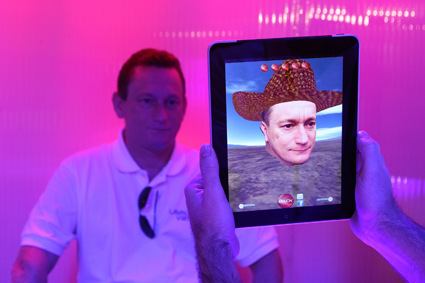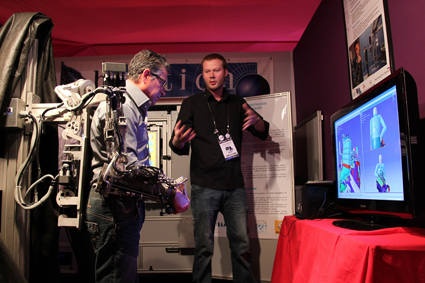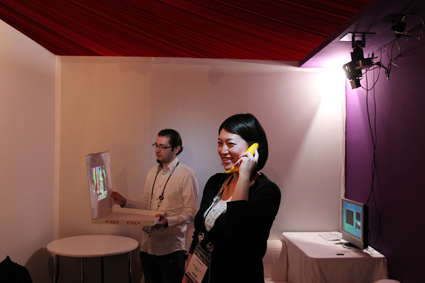journey into virtuality & convergence
ricardo peach: laval virtual international conference & exhibition

DigitEYEzer, Laval Virtual 2011
photo Jean-Charles
DigitEYEzer, Laval Virtual 2011
THE LAVAL VIRTUAL INTERNATIONAL CONFERENCE AND EXHIBITION ON VIRTUAL REALITY AND CONVERGING TECHNOLOGIES IN FRANCE, IS ONE OF EUROPE’S LARGEST GATHERINGS OF VIRTUAL REALITY AND NEW TECHNOLOGY ENTHUSIASTS. THIS YEAR, OF THE 85 EXHIBITS PRESENTED AROUND 30% WERE FROM PLACES OTHER THAN FRANCE, INCLUDING AFRICA, JAPAN AND NORTH AND SOUTH AMERICA. THIS GLOBAL SPREAD DELIVERED AN ECLECTIC MIX OF INTERNATIONAL AND TRANSNATIONAL EXHIBITS.
I had never been to such an extensive industry convention before, especially one with a dedicated stream on virtual art. Not knowing what to expect, I armed myself with a detailed presentation, designed for those who could not speak English (lots of big images) and one that contextualised the Australian media art scene in more detail than I would present at home.
It was with great surprise then I discovered that all conference delegates had to present and were mostly conversant in English (also my second language) and that Australia’s contribution to media arts internationally was well known and understood by many present at the event.
Setting the context for the conference was renowned media arts theorist Erkki Huhtamo, Professor of Media History and Theory at UCLA. In his keynote titled “Hand Screens, Wrist Watches and iPads: an Archaeology of Wearable Media,” Huthamo asked the numerous artists, technologists and engineers at the conference to reflect for a moment on the history of mobile and immersive media.
This reflection illuminated a fascinating history of wearable and portable media devices, with objects such as pocket watches, cameras and hand-held personal fans seen as precursors to modern day hand-helds. In particular, fans were not only used for cooling, but also as symbols of social status and as print mediums for portable artwork and maps.
With evolving genres such as Device Art (think Bitman by Ryota Kuwakubo and Maywa Denki, 1998), this convergence of technology, art and design can be seen as an extension of those historical origins of portable media. By understanding the origins and symbolic meanings of these devices, Huhtamo suggested, contemporary artists and technologists are in a much better position to tap into their cultural legacy, and therefore be more successful in deploying them artistically and commercially.
Commercialisation was certainly the main driver for most exhibitors at Laval. The three projects I look at in this article—IFace 3D, Haption Exoskeleton and Invoked Computing—were all commercial with no particular focus on media arts, but like many of the exhibitors at Laval, were keen to harness the creative energy of users, including artists, for their inventions.
iface 3D— digitizer (france)
DigitEYEzer exhibited their recently released smartphone application iFace 3D, the first 3D face scanner available for mobile phones. With iFace 3D, users create 3D, lifelike models of themselves or their friends or anything close at hand, by shooting moving images on their phones and sending them to a 3D reconstruction server online. After a few minutes the user is then sent back the 3D model, ready for printing or publishing on the net. These 3D representations can be downloaded into virtual games or sculpted into physical 3D models with 3D printers. Staff at the booth displayed an arresting 3D generated, colour sculpture of their Sales and Marketing Manager, Didier Sy-Cholet, something that’s possible for all users to do once they have their own scanned data (and access to a 3D printer).
The interest in photo-realistic self-representation in virtual games and social media is certainly there, so it will be interesting to see how artistic engagement with this application evolves. I wonder for instance, how Australian augmented reality projects such as Warren Armstrong’s (Un)seen Sculptures (2011) or Thea Bauman’s Digital Culture Fund project Metaverse Makeovers (2011) might engage audiences with these new tools in times to come.

Haption, Exoskeleton Demonstration Booth, Laval Virtual 2011
photo Jean-Charles
Haption, Exoskeleton Demonstration Booth, Laval Virtual 2011
haption exoskeleton (france)
Haption’s force-feedback exoskeleton was one of the more intriguing exhibits to play with at Laval. Established in 2001, the company develops high performance haptic [touch-based] instruments and programs involving force-feedback in virtual reality, for both industrial and academic purposes.
Stepping into the exoskeleton at the booth, I felt a bit like Ellen Ripley from Aliens (without the sweat and the attitude), but instead of killing an acid-spitting critter, I had to put a virtual peg in a virtual hole.
The feedback system in the exoskeleton was fantastic, as it provided force-feedback on all six degrees of freedom (translations and rotations), which is essential for a realistic interaction with 3D objects. I was so mesmerised by the actual physical feedback that I never got the peg near the hole.
In terms of haptic feedback systems and Australian arts practice, I could imagine artists such as Keith Armstrong (Intimate Transactions, 2008), Jonathan Duckworth (Embracelet, 2007), Margie Medlin (Personal Space, 2007) or Stelarc (Exoskeleton, 1998) having great fun exploring the force-feedback systems linked to virtual space.
A recent haptic focused ARC Linkage grant supported by the Australia Council, bringing together artist Paul Brown, Dr Ben Horan from Deakin University’s School of Engineering and Saeid Nahavandi, Director of Deakin’s Centre for Intelligent Systems Research, could also be situated in this context. The three-year grant aims to help visually challenged people ‘see’ artworks through haptic vibrations; force-feedback systems such as these could add a dynamic new dimension to future projects.

nvoked Computing, Laval Virtual 2011
photo Jean-Charles
nvoked Computing, Laval Virtual 2011
invoked computing (japan)
One of the most innovative and, to my mind, potentially game-changing projects to emerge at Laval this year was Invoked Computing. Developed by Alexis Zerroug (France/Japan), Alvaro Cassinelli (Uruguay/France/Japan) and Masatoshi Ishikawa (Japan) through the Ishikawa Komuro Laboratory at the University of Tokyo, the project explores a “ubiquitous intelligence” capable of recognising specific human actions and projecting sound and images onto objects linked to these actions.
The example shown at Laval involved taking a banana and bringing it closer to the ear, with the gesture triggering directional microphones and parametric speakers hidden in the room. These devices then made the banana function like a phone. Not only would the banana ring, but you could talk using the banana as a handset. The developers also used a pizza box with projected images that could follow the box around in space.
The potential for these tools in performance and installation based work is mindboggling. Imagine having any object in a space able to project sound or images and interact with those around it. What could PVI Collective (Transumer, 2010) do with this technology if they deployed it in public spaces? Or Back To Back Theatre (Small Metal Objects, 2005) with accidental audiences at train stations?
Not surprisingly Invoked Computing received the Grand Prix du Jury for Laval 2011.
australian developments
In Australia there is huge scope for artists working in virtual reality and converging technologies to continue their internationally recognised practice. Recently, with funding through the Digital Culture Fund, some fantastic live, digital projects were realised with work such as the Roller Derby extravaganza Bloodbath by Bump Projects (2010; RT100) and Adriaan Stellingwerff’s Windy and Winding (2010), a virtual balloon travel application for smartphones.
In September this year at ISEA in Istanbul, the Australian Centre for Virtual Arts is curating a major program of Australian virtual artists, titled Terra Virtualis. In addition, an Australian exhibition on robotics curated by Kathy Cleland and an exhibition titled The World is everything that is the case, curated by Sean Cubitt, Vince Dziekan and Paul Thomas will also be flying the flag.
But the most significant development for experimental art in Australian in 2011 is the recently announced Creative Australia fund, a $10 million initiative from the Federal Government.
This funding is targeted to support individual artists through the creation and presentation of significant new work and fellowships and will be rolled out by the Australia Council over the next five years.
All the Council’s artform boards will be delivering on this initiative, with the knowledge that digital culture and the potential of the national broadband network will no doubt be key considerations of many applications. We are all looking forward to seeing the outcomes of such a significant investment in contemporary Australian arts practice.
RealTime issue #104 Aug-Sept 2011 pg. 41






